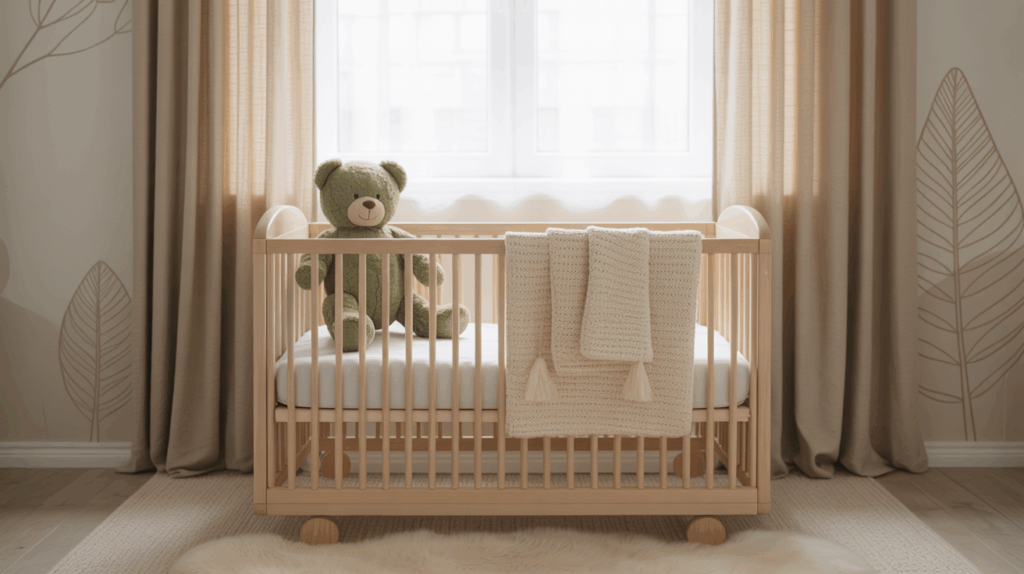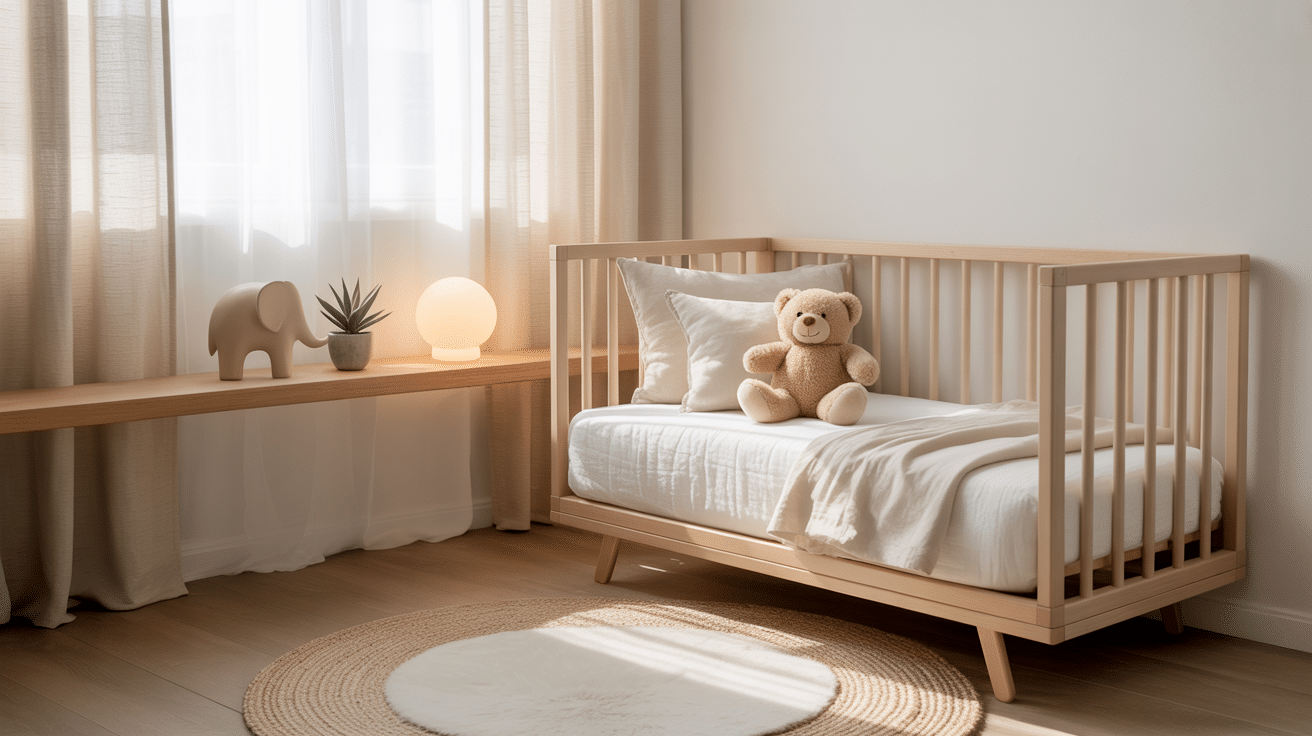Scandi Nursery Corner in Parents’ Room with Simple Design
Table of Contents
A calm and stylish nursery corner within reach
For many new parents, setting up a dedicated nursery room may not be possible—or even necessary. Whether due to limited space or a desire to keep baby close, designing a small yet stylish nursery corner within the parents’ bedroom is a practical and heartwarming solution. When approached with Scandinavian-inspired simplicity, this shared space becomes more than just functional—it becomes a beautifully designed haven for rest, bonding, and comfort.
Scandinavian design is rooted in minimalism, natural textures, and warm functionality. Its principles are perfect for a nursery corner: think clean lines, neutral tones, and clutter-free spaces. The key lies in blending baby’s needs seamlessly into the parents’ room while maintaining a peaceful atmosphere for both.
This article guides you through building a Scandi nursery corner in your own bedroom. From furniture selection to textile layering and storage tips, you’ll learn how to balance design with purpose. We’ll explore how to zone the nursery space thoughtfully, use light effectively, and add cozy touches without overwhelming a small area. Whether you’re preparing for your first baby or optimizing your current setup, this minimalist yet cozy approach will inspire and reassure.
Zoning the Nursery Corner without Overwhelming the Room
Incorporating a nursery into an existing bedroom requires smart visual separation. Without actual walls, zoning can be achieved through layout, furniture placement, and subtle decor cues.
Start by identifying the best spot in the room—typically a corner away from distractions, near an outlet for nightlights or sound machines, and within easy reach from your bed. A crib, bassinet, or mini crib will anchor the zone. Surround it with soft lighting and cozy textures to distinguish it from the adult side of the space.
Use rugs, curtains, or slim furniture to visually break the space. A small area rug beneath the crib can subtly signal the “baby zone” without disrupting flow. Tall shelving units or a hanging canopy also work well as spatial markers.
Zoning Visual Guide:
| Zoning Element | Function | Best Use Case |
| Area Rug | Ground the nursery zone | Place under crib or chair |
| Crib Placement | Defines main nursery function | Adjacent to parent’s bed for access |
| Floating Shelf or Art | Adds height and visual distinction | Above crib or changing table |
| Lighting Fixture | Marks zone and adds ambiance | Small pendant or wall-mounted sconce |

Choosing Scandinavian Furniture for Small-Space Nurseries
Scandi furniture is the hero of small-space parenting. Its clean, functional design naturally reduces visual clutter while offering long-lasting quality and charm.
When selecting furniture, prioritize dual-function pieces. A crib with built-in drawers, a wall-mounted changing table, or a dresser that doubles as a nightstand saves precious space. Stick to pale woods, white or soft gray finishes, and furniture with rounded edges—safe for baby, soothing for the eye.
Keep the palette tight. Too many tones—even neutrals—can make the space feel busy. Scandinavian nurseries often follow a strict white, beige, and birch color story. A pop of muted mustard, sage green, or blush can add personality without disrupting harmony.
Scandi Furniture Guide:
| Piece | Key Features | Ideal Placement |
| Compact Crib or Bassinet | Neutral tones, simple structure | Beside parent’s bed or near window |
| Open Shelving | Airy, vertical storage | Above changing station or corner wall |
| Dresser with Changing Pad | Dual use, minimal surface items | Next to crib or at foot of bed |
| Rocking or Nursing Chair | Wooden frame, upholstered cushion | Tucked into corner with soft lighting |

Keeping the Color Palette Minimal and Soothing
The Scandinavian color palette centers around calm and clarity. Whites, creams, light woods, and cool grays are staples—but when designing a nursery corner, it’s important to balance serenity with warmth.
The walls should remain light to maximize natural brightness. If you’re renting or avoiding permanent change, opt for removable wallpaper or wall decals in soft shapes like clouds or abstract rainbows. Use fabric tones to bring depth—think oatmeal muslin swaddles, taupe linen curtains, and ivory knit blankets.
Introduce gentle contrast through small decor: a pale terracotta basket, a soft green cushion, or a sand-toned stuffed animal adds just enough variation to keep things visually interesting.
Palette Planning Table:
| Base Color | Accent Options | Suggested Use |
| White / Cream | Soft gray, taupe | Walls, crib, bedding |
| Birch Wood | Pale terracotta | Furniture frames, toy bins |
| Sage Green | Blush, warm sand tones | Cushions, artwork, textile accessories |
Avoid overly bold patterns or loud hues—they detract from the tranquility that’s essential in both nursery and parent zones.

Storage Solutions That Keep Clutter Out of Sight
One of the biggest challenges of sharing a room with baby is managing clutter. Scandinavian design thrives on simplicity, so storage must be smart, hidden, and intentional.
Opt for baskets made from natural materials like seagrass or cotton rope. They’re both aesthetic and functional—perfect for swaddles, toys, or diapers. Use under-crib storage boxes to hide bulkier items like extra bedding. If you’re short on surface space, wall-mounted racks or peg rails provide vertical organization without crowding the room.
Labeling baskets and keeping a rotation system for clothes and toys (especially in the first year) helps maintain calm. As baby grows, this system evolves easily without requiring major redesign.
Clutter Control System:
| Storage Item | Best Use | Placement Idea |
| Woven Baskets | Toys, swaddles, diaper caddies | Under bench, beside crib |
| Drawer Dividers | Baby clothes organization | Inside shared dresser |
| Peg Rail with Hooks | Hanging blankets or organizers | Above changing area |
| Floating Shelves | Display soft decor, light books | High wall area to save floor space |
Textiles and Soft Touches That Bring Comfort
While Scandinavian design is known for minimalism, it never sacrifices comfort. In fact, texture is one of its secret weapons in making simple spaces feel warm and lived-in.
Start with the crib: soft fitted sheets in muslin or organic cotton, layered with a waffle-knit blanket or quilt (only when safe to do so). Add a plush rug underfoot—perfect for middle-of-the-night feeds or diaper changes.
For seating, choose a chair with a removable, washable cushion cover in linen or boucle. Drape a soft throw over the back for added comfort. A pouf or knit ottoman nearby doubles as a footrest and storage spot.
Curtains should be light-filtering, not blackout. Scandinavian rooms embrace natural light, even during baby’s naps. You can layer sheer curtains with a linen panel for balance.
Comfort Layering Checklist:
| Textile Item | Material Suggestion | Comfort Purpose |
| Crib Sheet | Organic cotton, muslin | Soft and breathable for baby’s skin |
| Area Rug | Wool, cotton blend | Cozy underfoot and zones the space |
| Throw Blanket | Knit, linen blend | Adds softness to seating or bedding |
| Curtain Panels | Linen, semi-sheer | Filters light gently |
Conclusion
A Scandi nursery corner in a parents’ room proves that thoughtful design doesn’t require extra square footage—it requires clarity of intention. With its clean lines, neutral tones, and clever use of space, this design approach offers a peaceful environment that supports both parent and baby in those early months.
By focusing on functionality, texture, and light, you can craft a shared room that feels cohesive, calming, and completely your own. Whether you’re preparing for your first child or refreshing your current space, embracing Scandinavian simplicity ensures your nursery corner is not only beautiful but beautifully livable.

